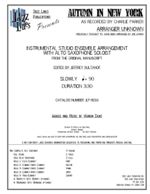AUTUMN IN NEW YORK [DOWNLOAD]
Recorded by Charlie Parker with Strings
Arranger Unknown, Prepared by Jeffrey Sultanof and Rob DuBoff

Cat #: JLP-8016-DL
$85.00This product is available for immediate download after purchase.
Questions?
Please call +1-518-587-1102 or email us.
Edition: Jazz Studio Orchestra Arrangement
Description: Swing - Difficult
Publisher: Jazz Lines Publications
Background:
The hit side of the January, 1952 recording date (the tape boxes are not marked), Autumn in New York, was one of the biggest hits written by composer Vernon Duke. Duke led a double life; as Vladimir Dukelsky, he composed concert music, including a ballet commissioned by Serge Diagalev of the Ballet Russe (The Rite of Spring was another Diagalev commission). As Duke (a name suggested by his friend George Gershwin), he wrote many wonderful songs for shows that were not very successful. His music has had a resurgence of interest in recent years, with many new recordings of his scores and individual songs.
The Music:
Thanks to the rediscovery of the original scores and parts of the Bird with strings arrangements, we now know that Joe Lipman did not arrange Autumn in New York. The handwriting on the score is totally different from scores where Lipman's name is on the title page, and there is no name to be found on Autumn. Based on the amount of copy errors on the parts of 'Temptation,' it is clear that this recording date was prepared in a hurry, and obviously Lipman could not finish all four scores scheduled. So a 'ghost' was hired to write this score.
Ghosting became very common among arrangers when radio networks (stations throughout the country grouped together by organizations such as the Columbia Broadcasting System [CBS] and the National Broadcasting Company [NBC]) were formed in the late 1920s. With the amount of local and national programming broadcast every day that demanded many pages of music to be played live, staff arrangers who got into a bind made a phone call to one or several other arrangers to get the job done. During the big band era, Horace Henderson completed arrangements for Benny Goodman that were credited to his brother Fletcher. After the war, the recording and television industries provided work for hundreds of arrangers from coast to coast, and there was more than enough activity to keep them busy. No one cared about getting credits on record labels or album covers, the arrangers just wanted the work. In New York, Marion Evans, Billy Byers, Neal Hefti, Don Costa and a few other arrangers lived within several blocks of each other in the west 70s, and it was not uncommon for one arranger to call another one to finish an arrangement while four or five copyists sat in an apartment and cranked out parts for a date that would begin twenty minutes from the arrival of the 'ghost.'
Whoever wrote Autumn in New York for Parker was clearly a 'commercial' writer, and this is not meant in a negative way. But there is not a saxophone besides Parker to be heard, and the bulk of the arrangement features the strings, although there are two 'written' solos played by trumpet and trombone. The arrangement is a straightforward setting that works beautifully and is not terribly difficult. One instrumentation note: this arrangement reminds us that it was easy to get top musicians in New York when an arranger could write three reed parts that call for bass clarinet.
Notes to the Conductor:
This arrangement is a perfect introduction for a jazz ensemble combined with a string section. Rarely do high school and college string players have opportunities to play popular music of this quality because it is simply not available, a situation that we at Jazz Lines Publications are slowly rectifying.
Every musician must hear the rhythm section, particularly the drums so that all players can be in synchronization. The reason this arrangement makes such a good first 'chart' for orchestra is that issues such as playing behind the beat and intonation between strings and winds are minimized.
Dynamics are pretty much as indicated by the arranger. There were instances where triple-p was written on the manuscript, which is totally impractical for live performance. Proper balance between the woodwinds and strings is crucial, as the winds can be easily buried. Amplification of the instruments may help, or the dynamics may have to be altered depending on your performance space.
This was recorded in 1952 and is presented here directly from the original manuscript. This is NOT a transcription. However, everything Parker played on this recording has been transcribed and presented here as-played, though we have also included (in a separate staff) what was originally written for him. So, this arrangement can certainly be played without the need to mimic Bird. This chart was scored for solo alto sax, 2 altos (both double flute), 2 tenors (both double clarinet and bass clarinet), baritone sax (doubles clarinet), 3 trumpets, 2 trombones, 4 violins, 2 violas, 2 celli, harp, guitar, piano, bass, and drums. The brass parts have been augmented to 4 trumpets and 4 trombones. In addition, this may be used as a vocal arrangement (Key of Eb).
Solo Alto Saxophone (or vocal)
2 Flutes (both double clarinet)
2 Clarinets (both double bass clarinet)
1 Oboe (doubles clarinet)
4 Trumpets
4 Trombones
3 Violins
2 Violas
2 Celli
Harp
Guitar
Piano
Bass
Drums








